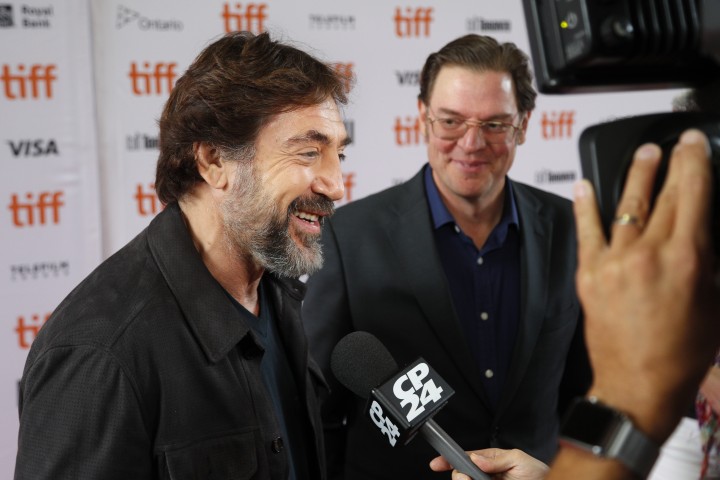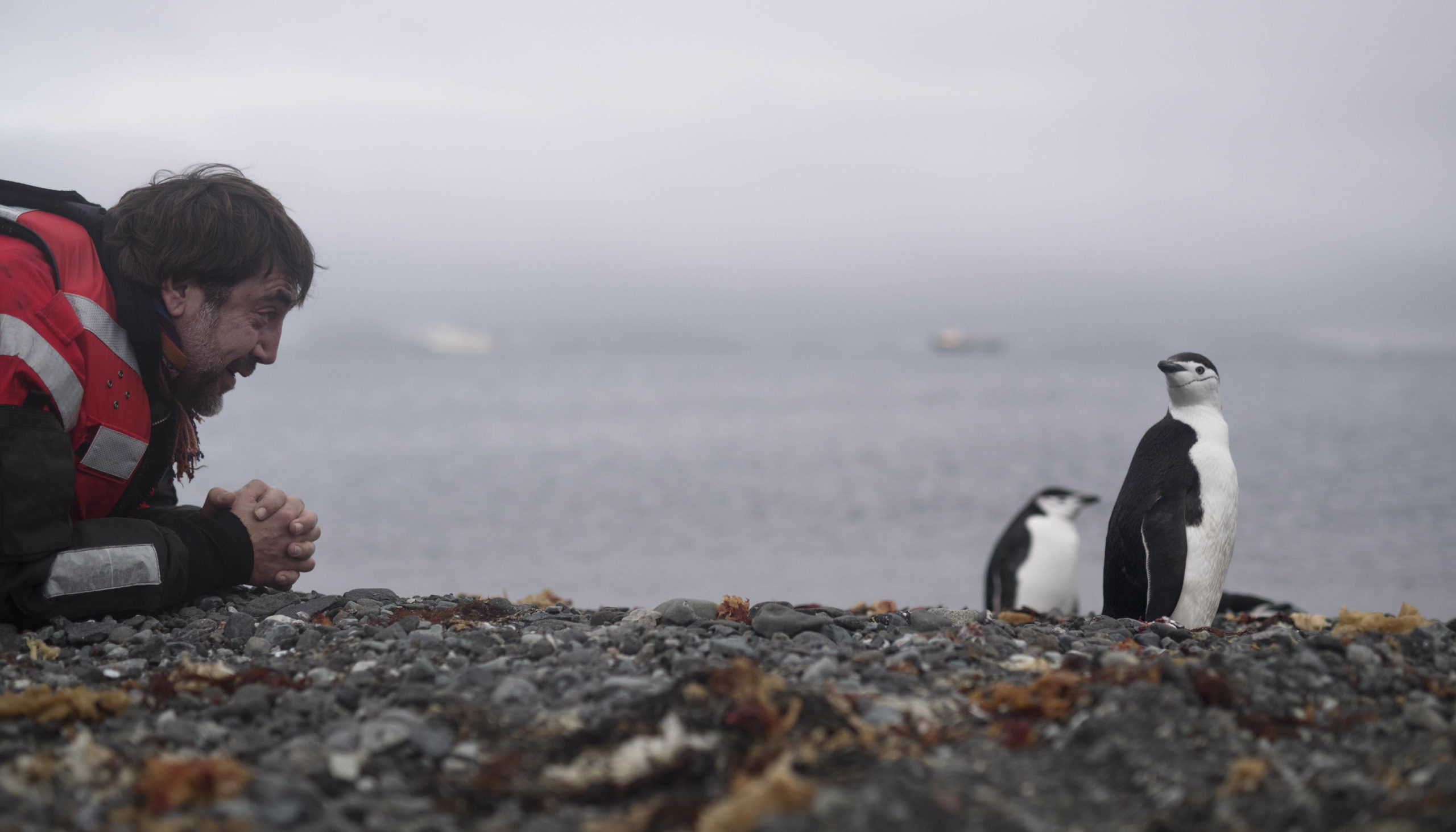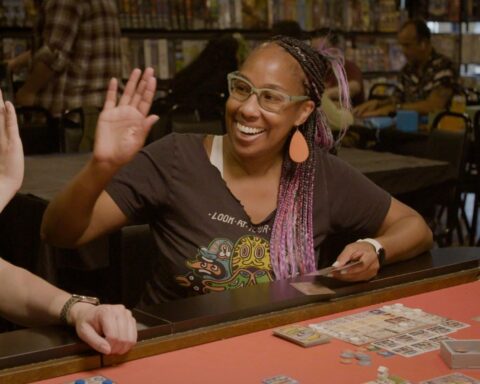Celebrity can make or break an activist documentary. They can overwhelm a message and overshadow the cause at the core of a film. But there is no denying the benefits of a major star’s presence in a campaign or a film. The attention they bring is invaluable.
The role of celebrity goes under the microscope in Sanctuary, an important new film about the fight to create marine conservation areas in Antarctica. At the core of the Greenpeace campaign is Academy Award winning actor Javier Bardem (No Country for Old Men, Skyfall) and his brother Carlos (Assassin’s Creed, Che) as they join an expedition of scientists in Antarctica and harness the power of social media to draw attention to the wildlife worth saving. Facebook Live videos bring up to the second feeds from the chilly waters, while Instagram and Twitter explode with likes and retweets as Javier inches close to the beloved penguins that inspire him. Director Álvaro Longoria (Sons of the Clouds) puts the brothers’ role at the core of the film, observing the effectiveness of a strong campaign, but also capturing the frustrating outcomes that might arise when the stars’ ability to generate exposure and support fails to inspire action from the politicians who can enact change.
Sanctuary premiered this week at the Toronto International Film Festival as Longoria and Javier Bardem kicked off a second life for the Antarctic campaign by screening the film as a special event for a live audiences. POV spoke with Longoria ahead of the film’s premiere.

POV: Pat Mullen
AL: Álvaro Longoria
This interview has been edited for brevity and clarity.
POV: How did you come to work with the Bardem brothers?
AL: My first documentary, which was called Sons of the Clouds, which was at TIFF, was with Javier as well. So we worked together and I know Carlos very well because I’m also a producer. Many years ago, Carlos and I did a movie together and we became friends. After that, I did a short for Greenpeace, Esperanto, which was the name of one of their boats. It was a 15-minute piece with Carlos on the Arctic. I’m one of the few people who’ve been to both the Arctic and the Antarctic.
POV: Can you explain for readers some of the difference between the Arctic and the Antarctic in terms of politics we see in Sanctuary?
AL: One difference is the Arctic was protected and it was hard to get to. Now it’s easier to get because the Northwest Passage is open. It’s very hard to control what’s going on there because the Russians are actively present there and there’s no regulation. It’s open waters regulation, which is something that we’ve been trying to change at the UN level. The Antarctic Treaty protects the Antarctic and makes it a safe haven. It’s theoretically easier to deal with the Antarctic because it is meant to be a safe haven.
POV: Now that you’ve done a few films with Greenpeace, how is it working with a partner on a film who’s also your subject?
AL: My major goal with respect to this question was not to become a publicity arm of Greenpeace. I think the audience would be turned off by that. Greenpeace give me absolute freedom to do whatever I want. There were no limitations, which was crucial for me because the moment you become part of the subject, you lose objectivity. We wanted to see what went wrong and what went right. As you see in the film, it doesn’t all go according to plan.
POV: Were you surprised by the outcome of the vote?
AL: I was very surprised. I was convinced they were going to approve the proposal because everything seemed to be going well and people told us that it looked very good. Sadly, it didn’t go through, but one thing my editor told me is that it’s bad for the planet but it’s good for the movie. The decision makes it a very different film. I think it reflects reality. We are all very concerned about the environment.
But there is a barrier right now between what people want and what politicians are doing. How do we drop that barrier? It’s not normal that you have three million people petitioning for a sanctuary in the Antarctic and it doesn’t go through because of some fishing company in China. This situation represents the global crisis. The global crisis is not happening because we use plastic, for example—it is happening because nobody wants to stop using plastic. Individuals who want to stop using plastic are not given the alternative. It’s always being thrown back to the individuals and we’re made to feel responsible. The regulators have to act. I wanted to show that the regulators work through bureaucracies with economic interests and are essentially not responding to the public will.
POV: Were you allowed to film the meeting and the vote at the end, or was it a dramatic choice to omit it?
AL: No, we were only allowed to shoot the beginning of the meeting. But it was two weeks of discussion, so I’m not upset. I would have had so much material and it would have been so boring. We shot some more recently [that is not in the film] when Javier went to the United Nations two weeks ago to fight for a network of marine sanctuaries. What happened after the film and after the sanctuary was rejected, Greenpeace went to the UN and asked for a bigger network of marine sanctuaries centers. They say that documentaries are never finished. They’re abandoned. But the story continues.
POV: I find that when it comes to environmental films, half of them are either very angry and get audiences you riled up and the other half aim to move you with the beauty of the world. Sanctuary does a nice balance between the two.
AL: I did not want to make either one of those two films. I didn’t want to make a film about angry people because I think the audience is tired of films that make them feel frustrated about something that is not their fault. Making people angry doesn’t make sense to me. For the beauty, I’m not National Geographic or the BBC. They can spend millions shooting marvellous wonders of nature. I thought it was more interesting to follow the campaign. My first question was why if they really need a celebrity to do this campaign. That’s how the film got started: let’s follow Javier and see how powerful social networks are. I tried to show how the social network campaigns are being filmed. You never see them behind the scenes or how those decisions are made. For Greenpeace, it was interesting for them to analyze themselves because they are essentially an organization that is based on campaigns.
POV: We see a lot of celebrity driven campaigns and celebrity driven documentaries. How do you work with someone like Javier Bardem without having his star status overwhelm the film?
AL: It’s crucial to have somebody that the audience can relate to in a documentary. Essentially, Javier represents the audience and the audience is thrown into this situation. Javier asks questions that you would ask or that I would ask. I wanted to make a film about that and not one about his career saving the world. I talked to Greenpeace about this all the time. I said I thought they were overdoing the celebrity thing in some campaigns. It’s great that people watch Javier with a penguin, but the underlying message needs to get through.
POV: March of the Penguins was such a massive success. Did you have concerns about making another film with penguins?
AL: They say penguins and dinosaurs work all the time. Javier’s obsession for penguins is real. His production company is called Pinguin Films. Penguins represent the essence of what’s going on in the Antarctic because they are the most fragile animals in this ecosystem. They cannot swim that far away. The moment that some fishing company takes all the krill, they die. Penguins are more directly involved with the drama.
POV: Social media can play a crucial role in the campaign and in the film, and now in the larger conversation with documentaries more generally. How do you translate social media activism into real world activism? Sometimes people might just be latching on to a trending topic as hashtag #activists and “Like! Campaigners” but not actually do anything offline.
AL: I think that is very dangerous and something we kept an eye on. We were constantly analyzing social media in this movie, and at the end of the day, that’s a reality. Social media is what is moving things now. We’ve tried to understand how to make the message get through because we’re having a lot of trouble with the people who are watching. Three million people actually signed the petition, but 20 million people watched the videos. Getting them to the next step is tricky. What happens between those steps for 17 million people who watched? What prevented them from signing? If you can get all those people to play an active role in the campaign, it would be fantastic. We tried to make the messaging on social media more profound, like in the Facebook Live videos. Those are more interactive and people can actually understand the message. It’s not just a beauty shot.
POV: Do you think social media can harm a campaign’s outcome in that regard? Like, say I’m a politician who sees that 20 million people watched the video, but only three million signed the petition, so I can say that those 17 million other people don’t care. One thing about metrics is that you can interpret them as you please.
AL: At the end of the day, politicians don’t really care much about what people think until they have to go to an election. I think the power of social media and the power of public opinion, which hasn’t really changed that much since democracy started, is to put politicians in an uncomfortable position so that they have to change the way things are. I think that’s the big challenge of social media—it can be very superficial. It is very hard to say something intelligent in 140 characters. You can simplify things, but that makes it hard for all the useful information to get through.
POV: You’ve produced some very high-profile films like Steven Soderbergh’s Che and Asghar Farhadi’s Everybody Knows, but your work as a director is in documentary. Is there a reason you favour one role in drama and the other in documentary?
AL: I am in love with documentaries. That’s my passion. I love directing documentaries because I can make things happen. All my documentaries try to have an effect. I remember seeing Michael Moore’s Bowling for Columbine and how Walmart stopped selling guns thanks to the documentary. I thought that was fantastic and realized that through documentary, you can make a difference.
My real job is producing fiction movies but documentary is my passion. I think they’re very different. Directing documentaries helps me as a producer because directors respect me more than they do most producers. Sometimes, directors can think that producers have no talent and that’s why they’re producers instead of directors. I don’t think I would want to direct fiction. When you do a documentary, you are part of an adventure, you go to the Antarctic or you go to different parts of the world, but fiction is all rehearsed and it’s so fake. Shooting fiction is boring. Documentary is an adventure.
POV: The word on climate change has gotten worse over the past year. Are you optimistic?
AL: It’s terrible, but I am very optimistic. I ask this question in my documentary to all the participants, “Are you optimistic?” They all say they have to be and I agree. Humans have the capacity to change things. That’s proven. At this point, it’s a decision for the survival of the species. Unless we start pressuring authorities to change the way things are, our species may not survive. The main driver of humanity is survival of the species. We have to go back to that instinct. It’s crucial.











